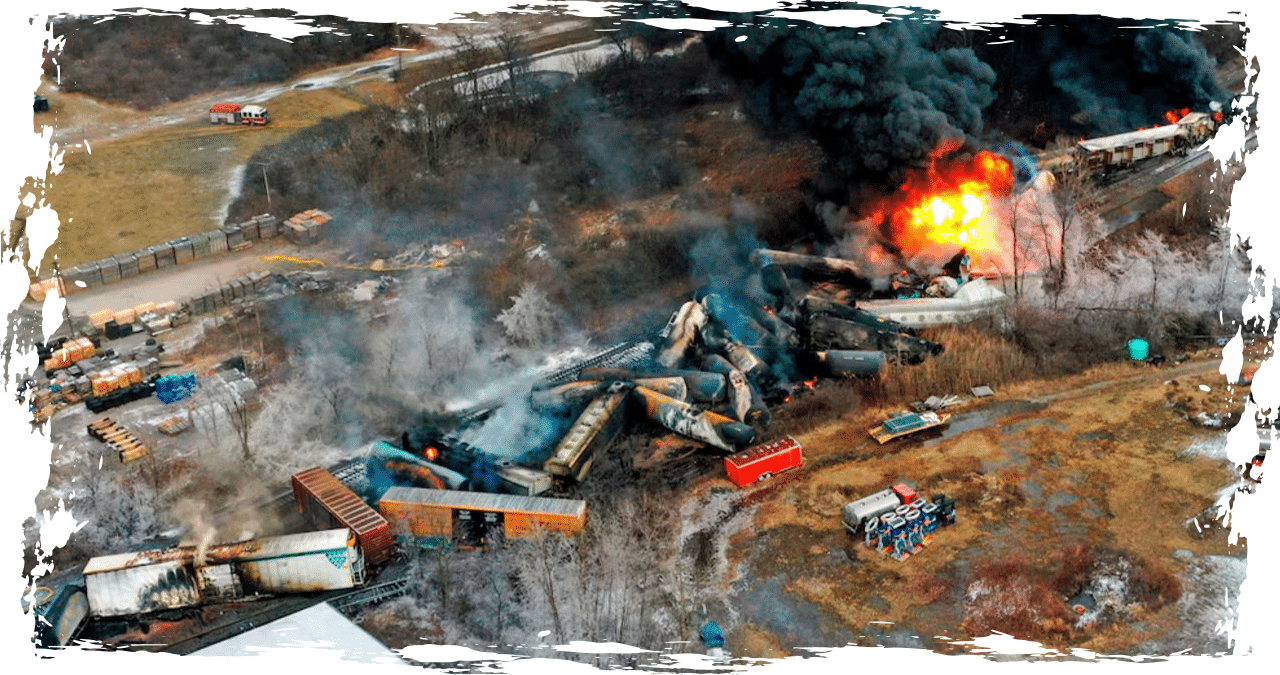According to a recent study, the aftermath of a significant train derailment in East Palestine, Ohio, resulted in the spread of “hazardous” pollution to 16 different states, extending far beyond the initial wreckage site.
According to a study published on Wednesday in Environmental Research Letters, on Feb. 3, 2023, a freight train operated by Norfolk Southern derailed in East Palestine, a village located on the border of Ohio and Pennsylvania. This event caused hazardous materials to be released into the air, soil, creeks, and lakes in the surrounding region.
According to a recent study, the pollution caused by the wreckage and the controlled burn of multiple train cars spread across 16 states in the Midwest, Northeast, and Southern regions of the United States. The pollution affected a significant portion of the country, covering an area of 540,000 square miles, which is equivalent to 14% of the total land area of the United States.
According to experts’ estimates, pollution has affected around 110 million people in the United States, which accounts for approximately one-third of the country’s total population.
During the incident, a total of eleven cars went off the track, all of which were carrying hazardous materials. Among these, five cars were loaded with vinyl chloride, which is a colorless gas that is highly unstable and used in various commercial applications. This information was provided by the Centers for Disease Control and Prevention and the National Institutes for Health at the time of the derailment.
According to reports from the agencies, a number of vehicles were transporting ethyl acrylate and isobutylene. These substances are known to be highly toxic and potentially carcinogenic.
According to a study, officials approved a controlled release and burn of vinyl chloride in five tanker cars three days after the initial crash. The authorization was due to the fear of a possible explosion in one or all of the cars. The tanker cars contained 115,580 gallons of the flammable gas. The controlled release and burn lasted for hours.
Residents expressed concerns about the potential negative health effects of the controlled burn, as a large ball of fire and a plume of black smoke filled with contaminants could be seen billowing out from the derailment site during the procedure.
The researchers conducted an analysis of rain and snow water samples collected from 260 sites in the surrounding states during the week of the derailment (Jan. 31) and the following week (Feb. 14). The findings of the study were published on Wednesday.
According to the study, the measurements indicated a significant impact area from the Midwest all the way through the Northeast, and potentially reaching Canada. It is also possible that the impact extended as far south as North Carolina.
According to the findings of the researchers, the Chloride and pH levels in northern Pennsylvania and along the U.S.-Canada border were found to be “exceptionally elevated” compared to the historic data.
The study highlighted that Pennsylvania, Michigan, Massachusetts, Wisconsin, and nearly all locations in New York showed the presence of soot, ash, and dirt in their samples.
The study found that pollutants were able to travel to southern states like Virginia, Tennessee, and Kentucky through the air.
According to the study, 19 locations were discovered to contain at least one chemical compound in the 99th percentile, while eight locations had four or more compounds present in the 99th percentile.
According to researchers, the effects of the fire were more extensive than the initial predictions, and this was probably because the fire lifted pollutants into the atmosphere. The researchers noted that the fire’s impact on the environment was significant in both scale and scope.
After the accident, Dr. Erin Haynes, who chairs the Department of Epidemiology and Environmental Health at the University of Kentucky, conducted a survey that involved around 400 adults residing in the East Palestine region. The objective of the survey was to understand the health impacts that the accident had on the residents of the area.
According to Haynes’ findings, the derailment had a profound impact on the health of the residents, with three out of four reporting negative health effects. More than half of the residents stated that they continued to experience these conditions even through the fall of 2023.
Haynes reported that individuals experienced symptoms including nose and eye irritation, coughing and wheezing, nausea, vomiting, diarrhea, rashes, and feelings of weakness and tiredness.
In April of 2024, Norfolk Southern reached a settlement of $600 million to address a class action lawsuit stemming from the train derailment.



